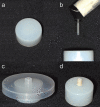Analysis of bond strength between a nylon reinforcement structure and dental resins
- PMID: 33981399
- PMCID: PMC8106934
- DOI: 10.4317/jced.57654
Analysis of bond strength between a nylon reinforcement structure and dental resins
Abstract
Background: Nylon is a polymer that its use to reinforce dental resins has shown positive results such as increased flexural strength. The aim of this study was to evaluate the bond strength between dental resins and a nylon reinforcement.
Material and methods: Forty cylindrical nylon blocks with 13 x 23 mm with 0.5% by volume of silica and 40 without were made. Half of the samples of each nylon composition were sandblasted with aluminum oxide (50μm) for 3 s (2.8 bar pressure, distance: 20 mm, incidence angle: 90o). On the nylon blocks, cylinders of chemically activated acrylic resin and indirect composite resin were made, with a bonding area of 6,28 mm2. Eight different groups were obtained according to the material used and the surface treatment (n = 10): Acrylic Resin + Nylon; GAS: Acrylic Resin + Nylon with Silica; GAT: Acrylic Resin + Nylon (Al2O3); GAST: Acrylic Resin + Nylon with Silica (Al2O3); GC: Composite Resin + Nylon; GCS: Composite Resin + Nylon with Silica; GCT: Composite Resin + Nylon (Al2O3); GCST: Composite Resin + Nylon with Silica (Al2O3). The shear test was carried out. The Student's and the Kruskal-Wallis test was adopted.
Results: There was no statistically difference in the bond strength for nylon with silica for the acrylic resin group. For the composite groups, nylon with silica did not present a statistically difference without surface treatment (p = 0.10) and with surface treatment the bond strength decreased (p = 0.000). The GCT showed a higher bond strength (0.89 MPa). The surface treatment improved the bond strength for the both groups.
Conclusions: The presence of silica in the nylon composition did not influence the bond strength between materials evaluated. However, the surface treatment with aluminum oxide proved to be favorable for this adhesion. Key words:Nylons - Resins, Synthetic - Structures Strengthening - Dental Research.
Copyright: © 2021 Medicina Oral S.L.
Conflict of interest statement
Conflicts of interest The authors declare that there are no conflicts of interest.
Figures




References
-
- Frazer RQ, Byron RT, Osborne PB, West KP. PMMA: an essential material in medicine and dentistry. J Long Term Eff Med Implants. 2005;15:629–39. - PubMed
-
- Jagger DC, Jagger RG, Allen SM, Harrison A. An investigation into the transverse and impact strength of "high strength" denture base acrylic resins. J Oral Rehabil. 2002;29:263–7. - PubMed
-
- Ali IL, Yunus N, Abu-Hassan MI. Hardness, flexural strength, and flexural modulus comparisons of three differently cured denture base systems. J Prosthodont. 2008;17:545–9. - PubMed
-
- Yadav NS, Elkawash H. Flexural strength of denture base resin reinforced with aluminum oxide and processed by different processing techniques. Journal of Advanced Oral Research. 2011;2:33–36.
LinkOut - more resources
Full Text Sources
Miscellaneous
